Revitalizing Recognition
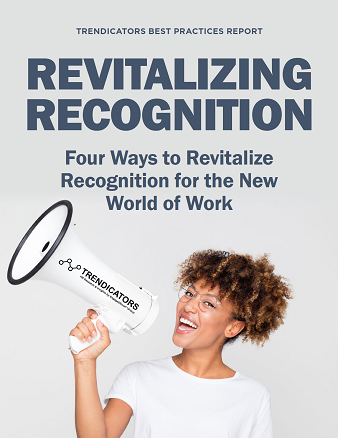
“After a year of profound change, innovators are revitalizing recognition experiences with training and tools to help managers become more effective at creating moments that matter.”
—ROY SAUNDERSON, CHIEF LEARNING OFFICER, ENGAGE2EXCEL GROUP
Trendicators is the research division of the E2E group of companies, leading providers of engaging career and consumer experiences. Trendicators provides original HR research, along with reports on insights and best practices from industry leaders and experts.
Roy Saunderson on the Difference Between Recognition and Rewards
 Roy Saunderson brings over 20 years of specialized knowledge and work experience to the field of employee recognition. He is the author of Practicing Recognition, Giving the Real Recognition Way, and 101 Ways to Give EVERYDAY Real Recognition. He is also a regular columnist for the magazines Incentive and Training as well as a popular blog writer. Roy developed the Recognition Strategy Model® for Roy Saunderson facilitating leader-driven recognition and co-authored the Recognition Chief Learning Officer Engage2Excel Group Skills Assessment®, a tool that measures the behavioral strengths of managers in giving effective recognition.
Roy Saunderson brings over 20 years of specialized knowledge and work experience to the field of employee recognition. He is the author of Practicing Recognition, Giving the Real Recognition Way, and 101 Ways to Give EVERYDAY Real Recognition. He is also a regular columnist for the magazines Incentive and Training as well as a popular blog writer. Roy developed the Recognition Strategy Model® for Roy Saunderson facilitating leader-driven recognition and co-authored the Recognition Chief Learning Officer Engage2Excel Group Skills Assessment®, a tool that measures the behavioral strengths of managers in giving effective recognition.
Q: Is there confusion about the difference between recognition and rewards among program owners and managers?
I believe that there is widespread confusion in the industry, not just among program managers but also within the service-provider community. It is important to understand that employee recognition is still an evolving field that has only been around for about 50 years. However, systems for rewarding performance first appeared in the late 1800s.
Q: What is the difference?
Rewards are transactional, whereas recognition is relational. Failure to distinguish between the two can result in suboptimal experiences for employees. Recognition is an intangible acknowledgment of people for their behaviors, personal efforts or contributions. Rewards are a tangible way of acknowledging the achievement of a specific goal. But without recognition from a manager, the emotional impact of a reward is lost. I like to view recognition as a transfer of positive feelings from one person to another.
Q: How has the past year influenced recognition trends?
We have seen a significant increase in concern for the emotional wellbeing of employees. We’re all feeling isolated and stressed, and for those working from home, there has been a loss of connection that directly impacts motivation, focus and productivity.
Q: How is technology influencing the quality of recognition experiences for employees?
As with all technology, effectiveness depends on how people use it. We’ve seen a tremendous surge over the past year from organizations that are using social recognition to create and amplify recognition moments and to celebrate accomplishments, large and small, in unique and creative ways. However, there are plenty of examples where this isn’t the case. Recently, a state agency encouraged everyone to send an eCard to their peers on Employee Appreciation Day. Only two of the 30 senior leaders participated. You can’t build a culture of recognition without senior leadership support.
Download
 hbspt.cta.load(123973, 'a50df5af-ce1b-4591-a000-2bd55681a7d5', {"region":"na1"});
hbspt.cta.load(123973, 'a50df5af-ce1b-4591-a000-2bd55681a7d5', {"region":"na1"});
Leaders Are Revitalizing Programs by Focusing on the 4 Cs of Meaningful Recognition
While widespread adoption of social recognition platforms has occurred, growing at a compound annual growth rate of 12.5% since 20181, the recognition programs and support delivered via these platforms become stale over time and need to be revitalized to remain fresh and relevant.
The pandemic has highlighted the importance of enabling social constructs that foster emotional connections at work. HR leaders who are on the front lines of their organization’s pandemic response programs are acutely aware of the need to promote a sense of belonging and appreciation, which is challenging when people are working in isolation. As one recognition leader put it, “We have the technology infrastructure in place. What we need now is to help people, particularly managers, better understand how to deliver recognition experiences that are meaningful.”
In creating this report, we conducted a review of what innovators are doing to revitalize their recognition programs. We have combined these ideas with best practice recommendations that fall into four categories that we call the four Cs of Effective Recognition. Our hope is that you will find this multi-dimensional view of recognition experiences a useful tool for evaluating and improving recognition within your organization.
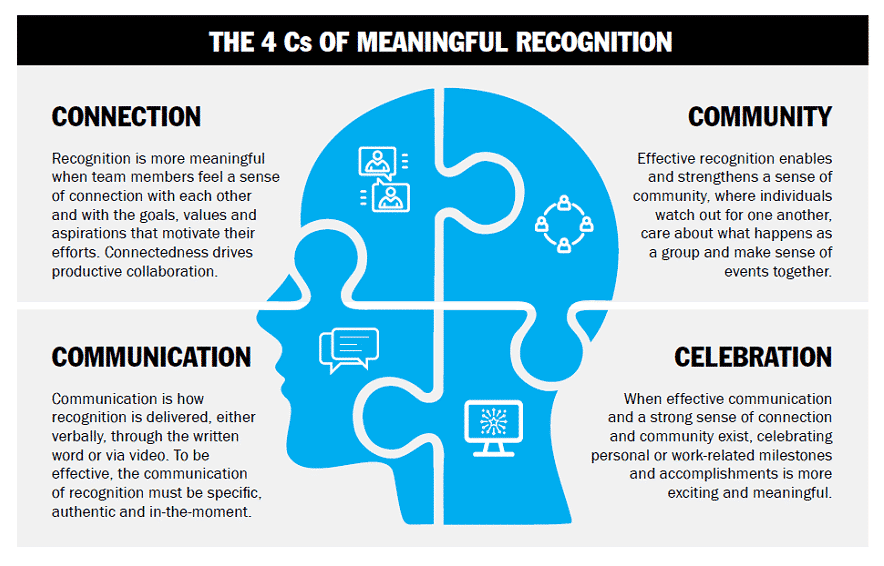
1. Global Social Employee Recognition Systems Market Report 2018-2026, Cadence Research
Download
 hbspt.cta.load(123973, 'a50df5af-ce1b-4591-a000-2bd55681a7d5', {"region":"na1"});
hbspt.cta.load(123973, 'a50df5af-ce1b-4591-a000-2bd55681a7d5', {"region":"na1"});

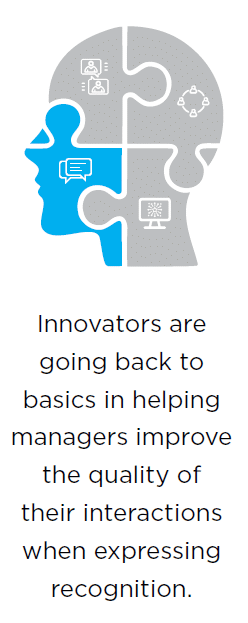
Effective recognition is both a personal and emotional experience.
Our review of what innovators are doing revealed that many are going back to basics in helping managers improve the quality of their interactions when expressing recognition. This includes providing training for managers to improve their recognition skills, evaluating recognition effectiveness through employee feedback and holding managers accountable for recognition in performance reviews. A survey by Dr. Jack Wiley revealed that managers vastly underestimate the importance employees place on receiving recognition2. Employees rank recognition as the second-highest priority in what they most want from their manager. When managers were asked what they thought their employees want from them, they put recognition last out of a list of eight attributes.
Help managers improve recognition experiences with more meaningful communication:
• Plan to make recognizing employees part of your daily routine. All it takes is a few seconds to communicate appreciation.
• Avoid using phrases like “good job” or ”well done.” Instead, describe the action or behavior of the employee and then describe the impact it had. For example, “Thanks for getting that report to me ahead of time. I now have extra time to work on the budget presentation.”
• Before team meetings, plan in advance who and what to recognize, then request others to share actions, behaviors or outcomes they’ve observed that deserve to be recognized.
• When peers compliment each other via social recognition, comment on the posts to amplify the impact.
2. The Employee Experience Gap, Trendicators Survey Report by Engage2Excel, 2020
Download
 hbspt.cta.load(123973, 'a50df5af-ce1b-4591-a000-2bd55681a7d5', {"region":"na1"});
hbspt.cta.load(123973, 'a50df5af-ce1b-4591-a000-2bd55681a7d5', {"region":"na1"});

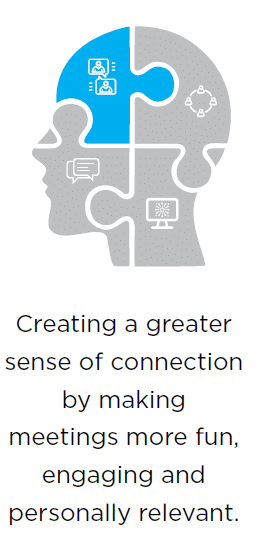 When team members feel connected, they perform and collaborate better.
When team members feel connected, they perform and collaborate better.
The pandemic has altered the social fabric of work. And while the prevalence of in-person meetings will increase as we get closer to herd immunity, virtual meetings are here to stay. In the meantime, working remotely has highlighted the need to make meetings more fun, engaging and personally relevant. This requires rethinking meetings to make them more interactive. We feel more connected when we learn things about others that we didn’t know, when we share perspectives on individual challenges and when we take on tasks as a group. Facilitating closer connections through virtual or in-person meetings improves engagement, a shared sense of purpose and more productive collaboration.
Techniques for creating and nurturing a closer connection in group meetings:
• Pre-think ways to make your next meeting more interactive and engaging. For example, ask everyone to turn off their cameras. Then, ask everyone who is celebrating a birthday or anniversary this month to turn on their cameras.
• Pose questions that will draw out individuals to share personal experiences or accomplishments, whether they are work-related or personal.
• Build interactivity into your next meeting. Select a topic and ask everyone to come prepared to share their perspective. Or pick a name out of a hat, and ask that person to share something at the next meeting that others don’t know about them.
Download
 hbspt.cta.load(123973, 'a50df5af-ce1b-4591-a000-2bd55681a7d5', {"region":"na1"});
hbspt.cta.load(123973, 'a50df5af-ce1b-4591-a000-2bd55681a7d5', {"region":"na1"});

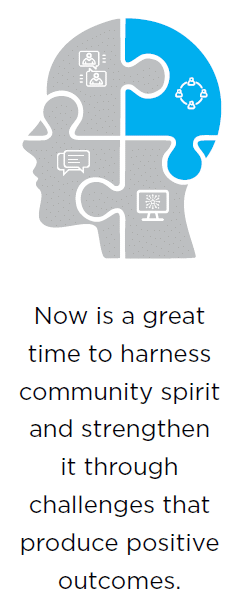 Now, more than ever, building a shared sense of community is vital.
Now, more than ever, building a shared sense of community is vital.
When people feel a sense of community at work, they form psychological connections and develop confidence that, by working together, they can achieve the tasks, goals and values shared by the group. The experience of going through the pandemic together has, in many ways, brought us all closer together. Now is a great time to harness community spirit and strengthen it through challenges that produce positive outcomes. The ideas below are designed to help build community within workgroups and teams. These same ideas can also be scaled to work within entire departments or organizations.
Help managers turn workgroups and teams into communities of shared interest and support:
• Brainstorm ideas for improving a specific performance variable. This could be quality, safety, customer service — anything measurable. Ask each team member to make specific recommendations for improvement. Implement the best ideas and measure their impact. This shared focus will produce positive outcomes and contribute to a greater sense of community.
• The process described above can be applied to the achievement of your organization’s corporate values, such as integrity, fairness or accountability. Discuss ideas for bringing these values to life in everyday interactions, and implement group-sanctioned ideas over a 30-day period. Then, ask people to report what they have learned.
• What social causes does your company support? Pick one or more that resonate with your team. Consider giving employees time off to make a difference. Make time for individuals to share their personal stories and experiences with the group.
Download
 hbspt.cta.load(123973, 'a50df5af-ce1b-4591-a000-2bd55681a7d5', {"region":"na1"});
hbspt.cta.load(123973, 'a50df5af-ce1b-4591-a000-2bd55681a7d5', {"region":"na1"});

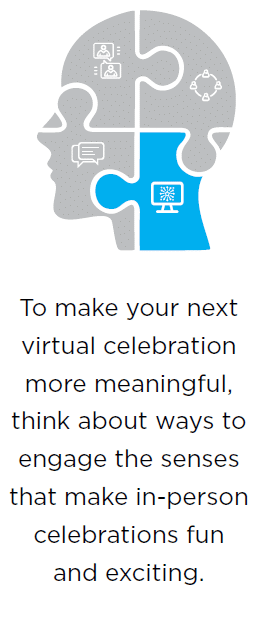 Virtual celebrations are new and take creativity to pull off successfully.
Virtual celebrations are new and take creativity to pull off successfully.
The act of celebration is an important part of workplace culture. It helps people take their minds off the tasks at hand and focus on shared acts of recognition and appreciation. Celebrations boost morale, strengthen teams and help bolster connections that increase engagement. But celebrating in a virtual environment is challenging; it takes planning and creativity. To make your next virtual celebration more meaningful, think about ways to engage the senses that make in-person celebrations fun and exciting.
Proven techniques for making virtual celebrations more fun and exciting:
• SOUND: Challenge a music aficionado on your team to pick soundtracks to open and close the event.
• SIGHT: Ask team members to create signs or posters to hold up to celebrate the individual or group being recognized.
• TOUCH: Send the award or gift ahead of time with a note not to open it until the designated time. Send party favors like hats and noisemakers to everyone in advance.
• TASTE: Cater the event using local restaurants or online providers like Door Dash, Uber Eats or services that specialize in virtual corporate events.
Take Advantage of These Webinar Resources to Make Recognition More Meaningful
 Planning for Better Recognition: If you want people to give better recognition and have people recognized more frequently than they are today, you must create a plan now that will transform recognition in the future.
Planning for Better Recognition: If you want people to give better recognition and have people recognized more frequently than they are today, you must create a plan now that will transform recognition in the future.
 Becoming A Better Recognition Giver: Becoming a great recognition giver can depend on many things, including your personality type. Learning new steps and ideas and implementing them into your recognition strategy will help you with your giving.
Becoming A Better Recognition Giver: Becoming a great recognition giver can depend on many things, including your personality type. Learning new steps and ideas and implementing them into your recognition strategy will help you with your giving.
 Celebrating Your Employees During the Pandemic: Learn to celebrate the things people are doing at work. No matter the individual circumstances of employees, whether working from home or back in the workplace, make sure you are celebrating their achievements and milestones better than ever.
Celebrating Your Employees During the Pandemic: Learn to celebrate the things people are doing at work. No matter the individual circumstances of employees, whether working from home or back in the workplace, make sure you are celebrating their achievements and milestones better than ever.
 How To Recognize Your Work From Home Employees: The coronavirus has more people working from home than ever before. To those now forced to work from home come both benefits and personal stresses. One area that many companies have not properly prepared Watch Now for is how to best recognize their newly remote employees.
How To Recognize Your Work From Home Employees: The coronavirus has more people working from home than ever before. To those now forced to work from home come both benefits and personal stresses. One area that many companies have not properly prepared Watch Now for is how to best recognize their newly remote employees.
Download
 hbspt.cta.load(123973, 'a50df5af-ce1b-4591-a000-2bd55681a7d5', {"region":"na1"});
hbspt.cta.load(123973, 'a50df5af-ce1b-4591-a000-2bd55681a7d5', {"region":"na1"});